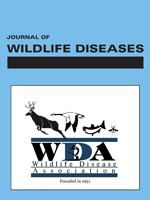In the Białowieża Primeval Forest (Poland) a chronic disease of the external genital organs has been observed in free-living male European bison (Bison bonasus) since 1980. Investigations on this disease started in the late 1980s. The most striking findings are necrotic and ulcerative lesions of the prepuce and penis of bison aged from 6 mo to >10 yr. Histologic examination of tissue samples from the prepuce of six bison (9-mo- to 8-yr-old), and from the penis of two bison (3- and 8-yr-old), were characteristic of necrobacillosis. Masses of slender, Gram-negative, rod-like or filamentous bacteria occurred in necrotic tissue. At the periphery of necrotic tissue filamentous bacteria were often arranged in large clusters and strands that advanced towards healthy tissue. Immunolabeling and electron microscopy also suggest that these organisms are Fusobacterium sp.
How to translate text using browser tools
1 April 2000
NECROBACILLOSIS IN FREE-LIVING MALE EUROPEAN BISON IN POLAND
Willi Jakob,
Hans-Dieter Schröder,
Michael Rudolph,
Zbigniew A. Krasiński,
Matgorzata Krasińska,
Olaf Wolf,
André Lange,
John E. Cooper,
Kai Frölich

Journal of Wildlife Diseases
Vol. 36 • No. 2
April 2000
Vol. 36 • No. 2
April 2000
Bison bonasus
European bison
Fusobacterium sp.
histopathology
necrobacillosis
necrotic posthitis and balanitis




